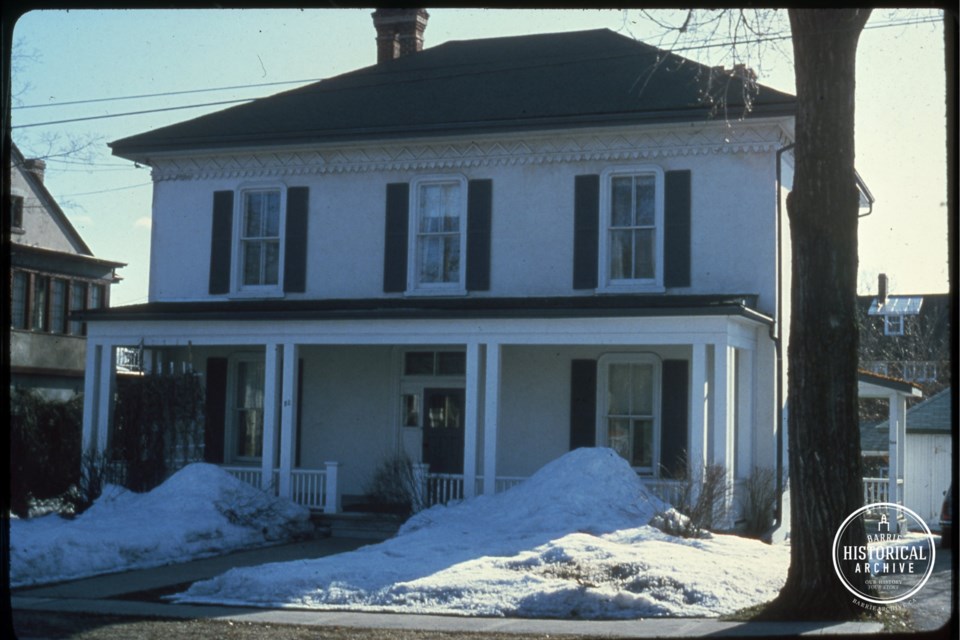This ongoing series from Barrie Historical Archive curator Deb Exel shows old photos from the collection and one from the present day, as well as the story behind them.
80 Toronto St.
“Mr. Wm. Boys New Residence – Of the new dwellings going up, the one being built by Mr. William Boys on Toronto Street deserves special notice. It will be a cottage style, built of frame and stucco plastered, and will cost about $3,000. He is the architect himself; Mr. John Palmer the contractor. The dwelling will have greenery and grapery in connection, and will be in other respects a model edifice.”
That was the description in an 1876 newspaper announcing the building of William Fuller Alves Boys’ new home. The carpenter/builder Palmer, was from England and his business was located on Mary Street. In 1871, at 33, he was a widower with three children. He is known for the Boys house which still retains much of its original design today, particularly the zigzag-patterned frieze under the eaves.
William Boys was born in New York City about 1833. Older brother Henry (always referred to a H.R.A. Boys) had been born in England in 1817 and would later own the Boys Block, which burned in the Dunlop Street fire of 1873. H.R.A. married Anne Sanford, daughter of Sidney Morehouse Sanford and sister of the shady Sidney James Sanford.
Our Boys, a lawyer, was by all accounts an active citizen in the community. He was a member of the Barrie Regatta Club, which was the first organization established (1846) exclusively for the purpose of pleasure boating. In 1855 when Boys was a member, Hewitt Bernard (who left Barrie in 1858 to be personal secretary to John A. Macdonald in the years leading up to Confederation in 1867) was president, Thomas Meldrum was vice-president and Joseph Rogers (who had once owned the land at 80 Toronto St.) was secretary/treasurer.
Boys was also one of the founders of the conservative newspaper The Spirit of the Age, which was published from 1858 until 1865.
William married Mary Frances Morgan, who was born in the West Indies in 1830 to Scottish/English parents, on July 8, 1863 in Barrie.
In 1873, William Boys was mayor of the town of Barrie (his son William would also be mayor of Barrie one day). It was in that year that William Ardagh contracted architect Shearman Bird to build a three-storey professional building on Owen Street, just above Dunlop Street. The Bank of Toronto was in the north end of the building and the post office was in the south section.
A decade later, it was 1883 and Boys was now a Simcoe County judge. A controversial site for a new post office was being proposed – on Station Gore. Local architect Thomas Kennedy was hired to design the new post office (bypassing the usual process of using a government architect) and it became the first federal building in Barrie.
Judge Boys wrote a Historical Sketch of the Town of Barrie to record and preserve the early history of the town. The document was placed behind the new post office cornerstone, which was laid in 1874.
Another notable resident of 80 Toronto St., was Arthur R. Girdwood. Girdwood was the principal of Barrie Collegiate Institute for 23 years. In the 1920s, when B.C.I. experienced a surge in student enrolment due to a 1921 ruling in Ontario raising the mandatory age to 16 for school attendance, Girdwood recommended hiring two more teachers and the construction of another wing to the school.
By the 1950s, Girdwood had retired from academia and was elected reeve for the town of Barrie.
Like Boys, Girdwood had thoughts about the old post office. With the federal offices now relocated from the post office square building to the new facility at Owen and Collier streets in 1955, a two-year debate began over what to do with the post office building and land.
One suggestion was for the town to acquire the old post office as a new municipal building: architects had declared it structurally sound and it could be remodeled for new use. Reeve Girdwood warned council about such an approach, that it could be expensive and “almost disastrous," reminding them of the modernization of the 1856 market building.
The 1950s saw the disappearance of much built heritage around Barrie in the name of progress. Corporations made offers on the post office property and organizations, such as the Barrie Art Club and the YM-YWCA, wanted space in the building – there was no shortage of interest and use for the building.
However, on April 28, 1958, council voted to demolish the building, to the dismay of so many citizens passionate about preserving what some considered to be the most beautiful historic building in Barrie. The land was rezoned for municipal use only in a September referendum.
William Boys’ “sketch” was retrieved when the post office building was demolished in 1958.



